The QNAP TS-h1283XU-RP is a rackmount 2U NAS based on the company’s QuTS Hero architecture. QNAP QuTS Hero is a new operating system that combines QTS with a 128-bit ZFS file system. QuTS Hero is aimed at optimizing performance and data protection. The new OS on the TS-h1283XU-RP NAS is said to deliver “server-grade performance” for use cases such as mission-critical file server, virtualization server, VDI, collaborative video editing, or efficient file backup and recovery applications.
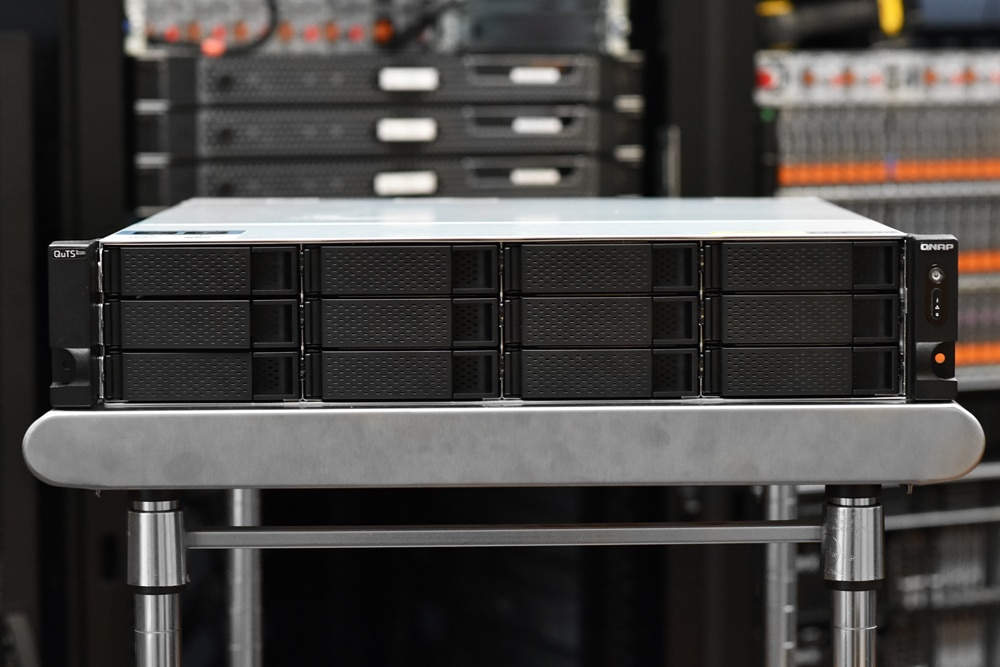
Looking at the hardware, the NAS packs an impressive Intel Xeon E processor with up to 128GB of DDR4 ECC memory (needed for optimal performance). The NAS comes with two 10GbE ports pre-installed (two RJ45, with two SFP+ 10GbE ports optional) for faster network connections. The system has 12 x 3.5” SATA drive bays, though some can be used with 2.5” SSDs for SSD cache acceleration. And there are several PCIe expansion slots for various other connections of which QNAP makes several. There are two options for this NAS, the TS-h1283XU-RP-E2236-128G and the TS-h1283XU-RP-E2236-32G. Basically, the only difference is the total amount of RAM either 128GB or 32GB.
While we covered QuTS hero a few times, this is our first review of the new OS (the specifics we will get to in a bit). As stated above, QuTS hero is a combination of the app-based QTS with a 128-bit ZFS file system. QuTS hero is aimed specifically at the QNAP business line of NAS. The OS comes with inline deduplication, inline compression, and inline compaction to help better utilize storage resources. The ZFS nature of the OS allows for self-healing to better boost reliability and maintaining data integrity. While conventional RAID configurations are supported, QuTS hero also supports RAIDZ.
Overall management of QuTS hero and “normal” QTS isn’t much different. One of the key differences is near-limitless snapshots. The OS supports up to 65,535 snapshots for iSCSI LUN and shared folders. At one per hour, this means users can store up to 7 years of snapshots without deleting any. The snapshots can be replicated to a remote server, but only the changes cross the wire, saving time and bandwidth. The new OS supports SnapSync remote snapshot backups adding another layer of enterprise-class DR.
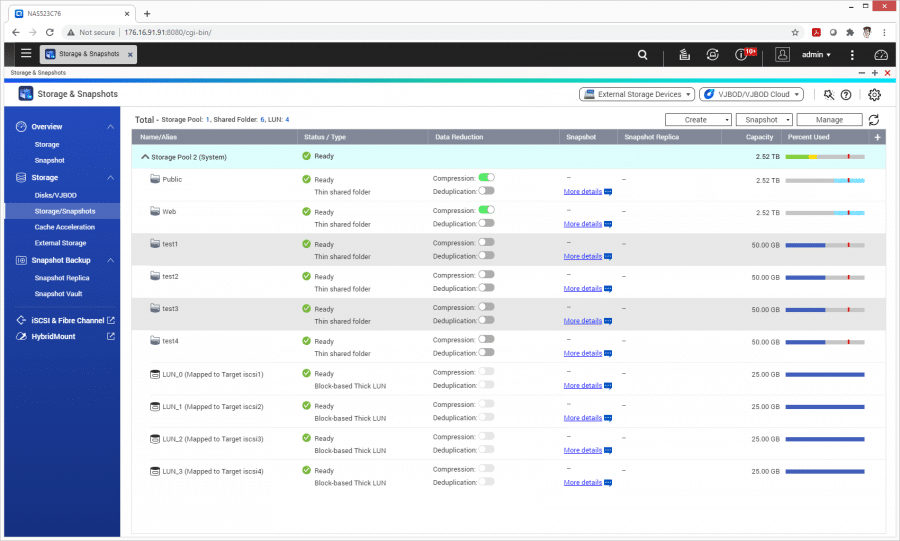
The TS-h1283XU-RP has 10GbE pre-installed and the new QuTS hero OS is said to be able to realize the full potential of 10GbE. The company states that users should see much better data transfer speeds compared to QTS and the inline deduplication should increase the transfer speeds further.
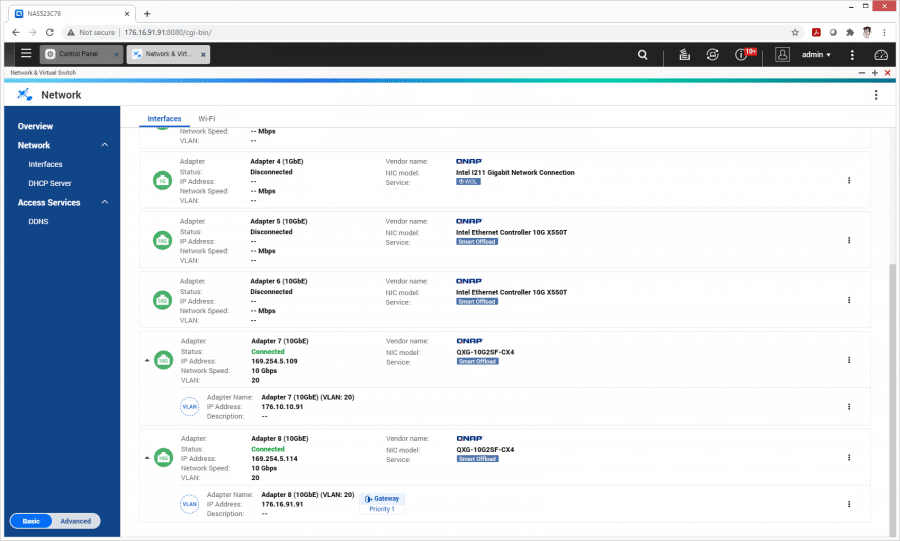
The QNAP TS-h1283XU-RP NAS is available now for about $4000 diskless. For this review, we are testing both HDD and SSD performance thanks to WD Red drives.
QNAP TS-h1283XU-RP NAS Specifications
| CPU | Intel Xeon E-2236 6-core/12-thread 3.4 GHz processor (burst up to 4.8 GHz) |
| CPU Architecture | 64-bit x86 |
| Wake on LAN (WOL) | Yes |
| Floating Point Unit | Yes |
| Encryption Engine | Yes (AES-NI) |
| System Memory | 32 GB UDIMM DDR4 ECC (2 x 16GB) |
| Maximum Memory | 128 GB (4 x 32 GB) |
| Memory Slot | 4 x Long-DIMM DDR4 |
| Flash Memory | 5GB (Dual boot OS protection) |
| Drive Bay | 12 x 3.5-inch SATA 6Gb/s, 3Gb/s |
| Drive Compatibility | 3.5-inch SATA hard disk drives 2.5-inch SATA hard disk drives 2.5-inch SATA solid state drives |
| Hot-swappable | Yes |
| SSD Cache Acceleration Support | Yes |
| Gigabit Ethernet Port (RJ45) | 4 |
| 10 Gigabit Ethernet Port | 2 x 10GbE SFP+ SmartNIC port, 2 x 10GBase-T port |
| Jumbo Frame | Yes |
| PCIe Slot | 4 |
| Slot 1: PCIe Gen 2 x4 (PCH) Slot 2: PCIe Gen 3 x8 (CPU) Slot 3: PCIe Gen 3 x4 (CPU) Slot 4: PCIe Gen 3 x4 (CPU) |
|
| USB 3.2 Gen 2 (10Gbps) | 2 x Type-C USB 3.2 Gen 2 5V/3A 10Gbps Port 4 x Type-A USB 3.2 Gen 2 5V/1A 10Gbps |
| Form Factor | 2U Rackmount |
| LED Indicators | HDD 1-12, Status, LAN, storage expansion port status |
| Buttons | Power, Reset |
| Dimensions (HxWxD) | 3.48 × 18.98 × 22.13 inch |
| Weight (Net) | 25.9 lbs |
| Operating temperature | 0 – 40 °C (32°F – 104°F) |
| Relative Humidity | 5-95% RH non-condensing, wet bulb: 27 ̊C (80.6 ̊F) |
| Power Supply Unit | 500W(x2), 100-240V |
| Power Consumption | 105.12 W Operating Mode, Typical |
| Fan | System fan: 2 x 60mm, 12VDC |
| Sound Level | 40.6 db(A) |
| System Warning | Buzzer |
| Max. Number of Concurrent Connections (CIFS) | 1500 |
QNAP TS-h1283XU-RP. Design and Build
The QNAP TS-h1283XU-RP is a 2U rackmount NAS. Across the front are 12 3.5” drive bays with QNAP branding on either side.
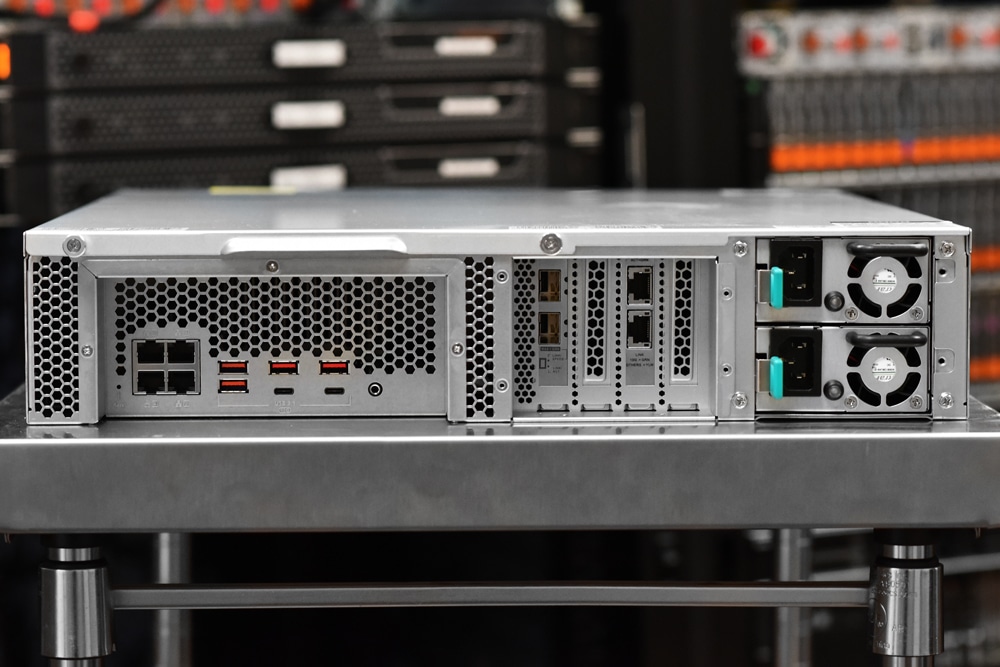
Flipping around to the rear, we see two PSUs on the right. On the left is four Gigabit Ethernet ports, six USB 3.2 Gen 2 ports (2 type C and 4 type A), four 10GbE ports through pre-installed expansion cards (dual-port 10GbE RJ45 NIC and a optional dual-port 10GbE SFP+ NIC), and two more PCIe expansion slots.
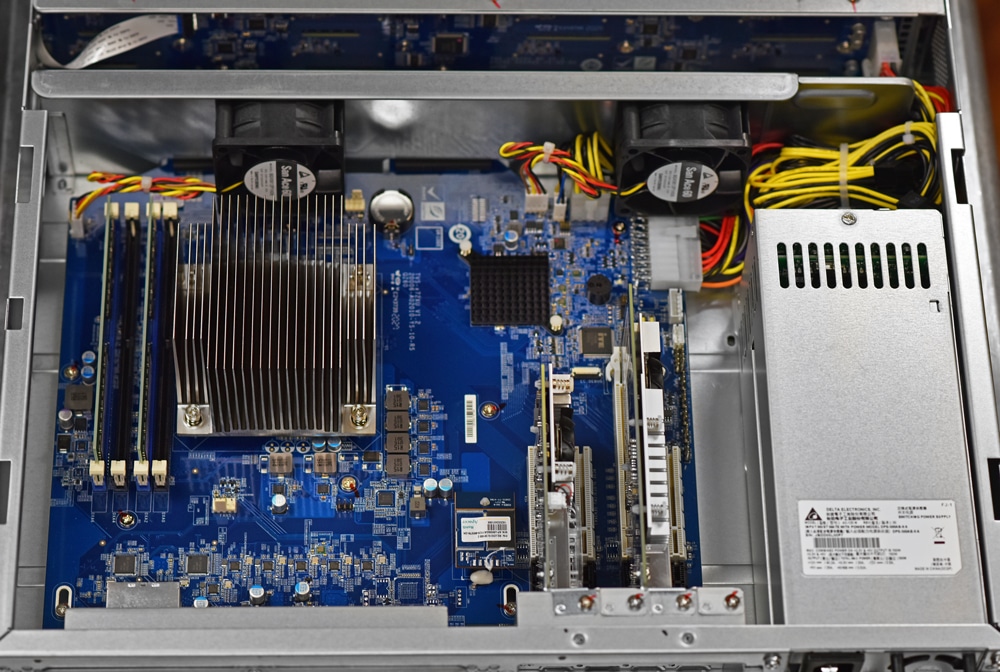
Opening up the device we can most prominently see the CPU and the DIMM slots on one side, while the expansion slots and PSUs take up the other.
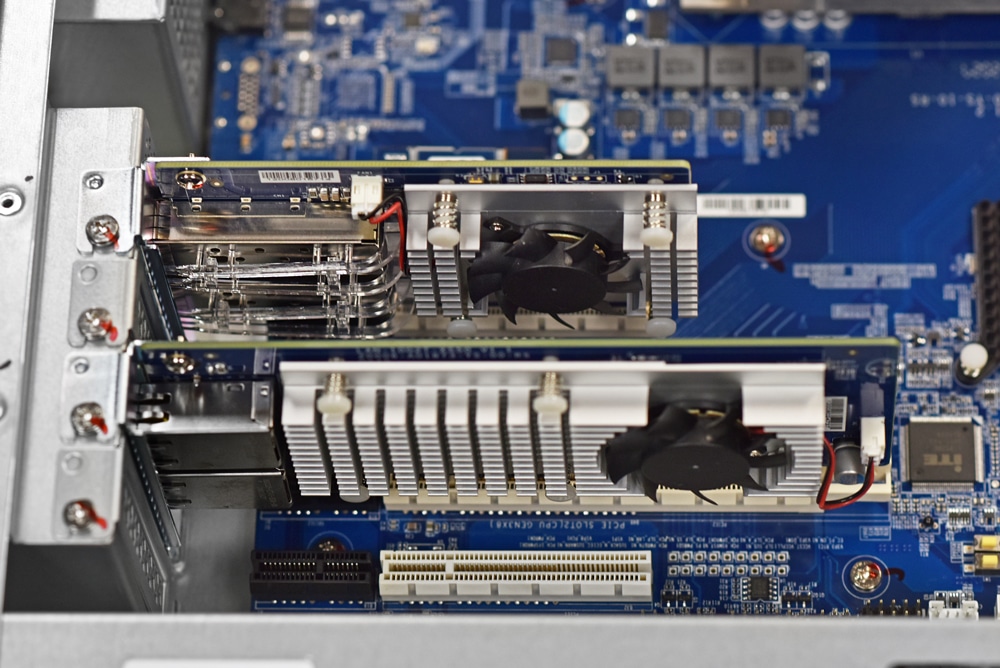
QNAP TS-h1283XU-RP Performance
Enterprise Synthetic Workload Analysis
Our enterprise shared storage and hard drive benchmark process preconditions each drive into steady-state with the same workload the device will be tested with under a heavy load of 16 threads with an outstanding queue of 16 per thread, and then tested in set intervals in multiple thread/queue depth profiles to show performance under light and heavy usage. Since NAS solutions reach their rated performance level very quickly, we only graph out the main sections of each test.
Preconditioning and Primary Steady-State Tests:
- Throughput (Read+Write IOPS Aggregate)
- Average Latency (Read+Write Latency Averaged Together)
- Max Latency (Peak Read or Write Latency)
- Latency Standard Deviation (Read+Write Standard Deviation Averaged Together)
Our Enterprise Synthetic Workload Analysis includes four profiles based on real-world tasks. These profiles have been developed to make it easier to compare to our past benchmarks as well as widely-published values such as max 4k read and write speed and 8k 70/30, which is commonly used for enterprise drives.
- 4K
-
- 100% Read or 100% Write
- 100% 4K
- 8K 70/30
- 70% Read, 30% Write
- 100% 8K
- 8K (Sequential)
- 100% Read or 100% Write
- 100% 8K
- 128K (Sequential)
- 100% Read or 100% Write
- 100% 128K
We tested both SMB and iSCSI performance with synchronize writes turned off, compression and deduplication disabled, with RAID6 configuration using eight WD Red 14TB HDDs and RAID5 with four WD Red SSDs.
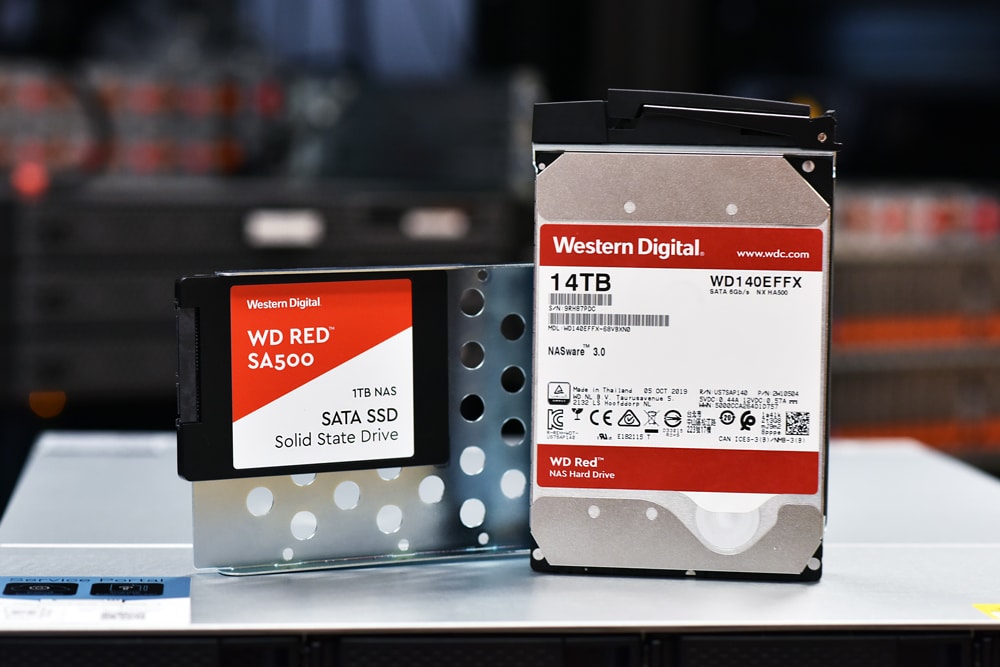
In the first of our enterprise workloads, we measured a long sample of random 4K performance with 100% write and 100% read activity. Looking at IOPS, the QNAP TS-h1283XU-RP with the HDDs saw 676 IOPS read and 565 IOPS write for iSCSI and 432 IOPS read and 192 IOPS write for SMB. With the SSDs the NAS gave us 5,590 IOPS read and 3,070 IOPS write for iSCSI and 4,376 IOPS read and 769 IOPS write for SMB.
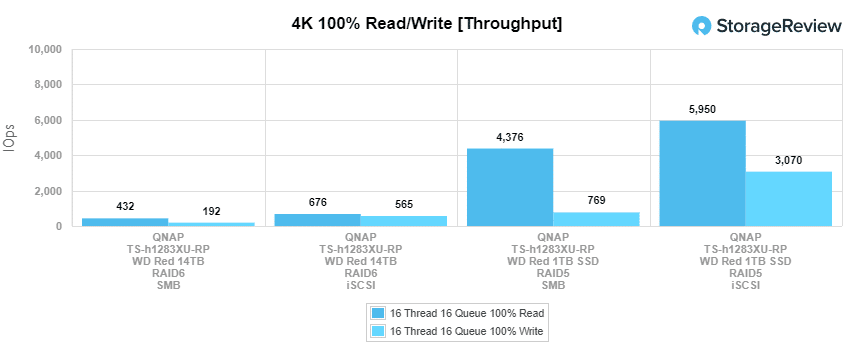
Next, we look at 4K average latency. For HDDs we got 378ms read and 333ms write for iSCSI and 591ms read and 1,326ms write for SMB. The SSDs resulted in 43ms read and 83ms write in iSCSI and 59ms read and 333ms write for SMB.
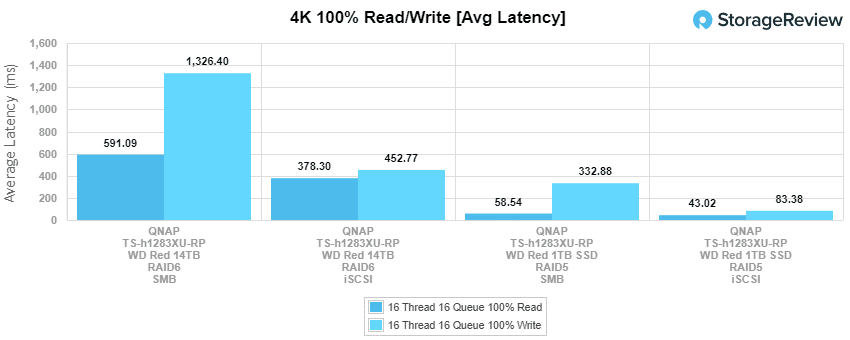
With 4K maximum latency the HDDs hit 4,407ms read and 4,269ms write in iSCSI and 2,620ms read and 4,456ms write for SMB. With the SSDs the latency dropped to 3,427ms read and 1,266ms write on the iSCSI config as well as 1,938ms read and 1,875ms write on the SMB side.
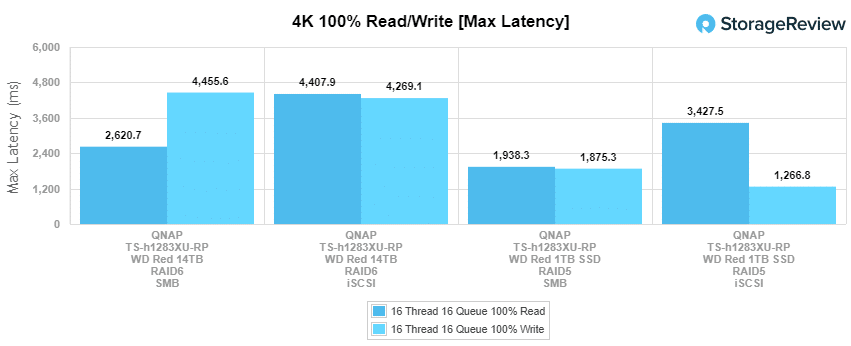
4K standard deviation gave us latencies of 415ms read and 491ms write for iSCSI and 553ms read and 1,193ms for SMB with HDDs. With SSDs the latency dropped to 108ms read and 98ms write in iSCSI and 94ms read and 289ms write in SMB.
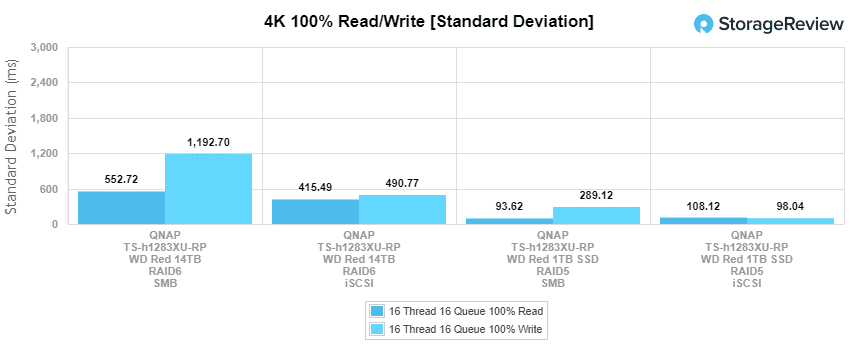
Our next benchmark measures 100% 8K sequential throughput with a 16T16Q load in 100% read and 100% write operations. Here, the iSCSI configured HDDs its 81,533 IOPS read and 62, 131 IOPS write. The SMB with HDDs saw 60,790 IOPS read and 33,909 IOPS write. With SSDs in we saw iSCSI hit 161,758 IOPS read and 133,028 IOPS write and the SMB hit 62,890 IOPS read and 35,307 IOPS write.
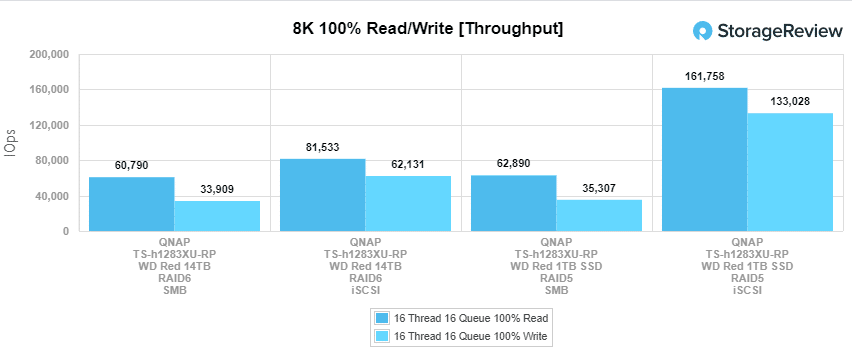
Compared to the fixed 16 thread, 16 queue max workload we performed in the 100% 4K write test, our mixed workload profiles scale the performance across a wide range of thread/queue combinations. For these tests, we span workload intensity from 2 threads and 2 queue up to 16 threads and 16 queue. With throughput, the HDDs saw highs of 625 IOPS for iSCSI and 348 IOPS for SMB. With the SSDs the NAS hit a high of 4,999 IOPS iSCSI and a high of 2,367 IOPS for SMB.
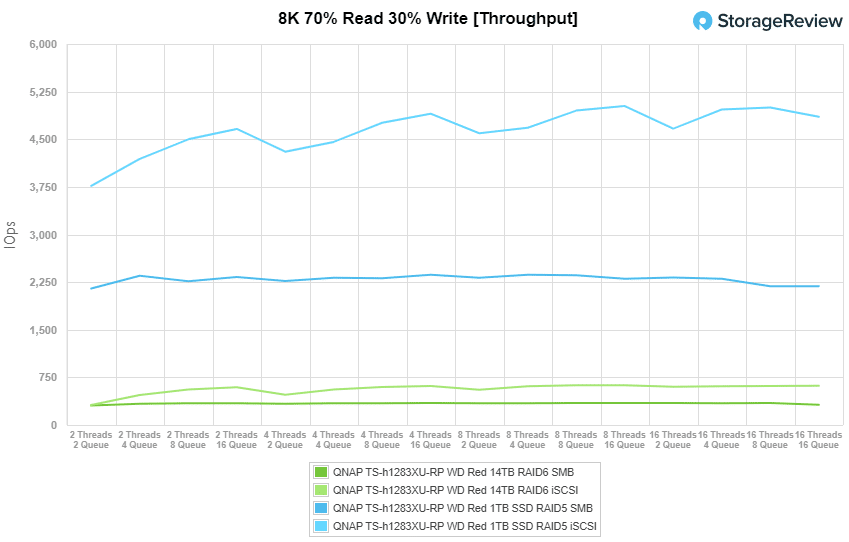
With average latency the HDDs saw a range of 12.7ms to 412.7ms for iSCSI and 13ms to 799.5ms for SMB. The SSDs fared better with a range of 1.1ms to 52.7ms for iSCSI and 1.9ms to 117ms for SMB.
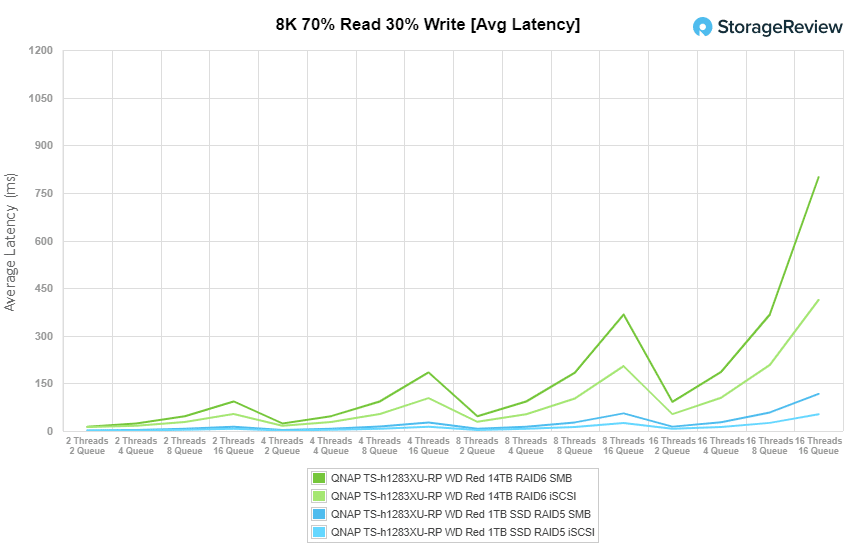
8K 70/30 maximum latency saw ranges of 107.9ms to 33,855ms for iSCSI and 231ms to 473ms for SMB with the HDDs. The flash storage was much improved but still high with ranges of 230.3ms to 3,729.5ms for iSCSI and 462ms to 1,860ms with SMB.
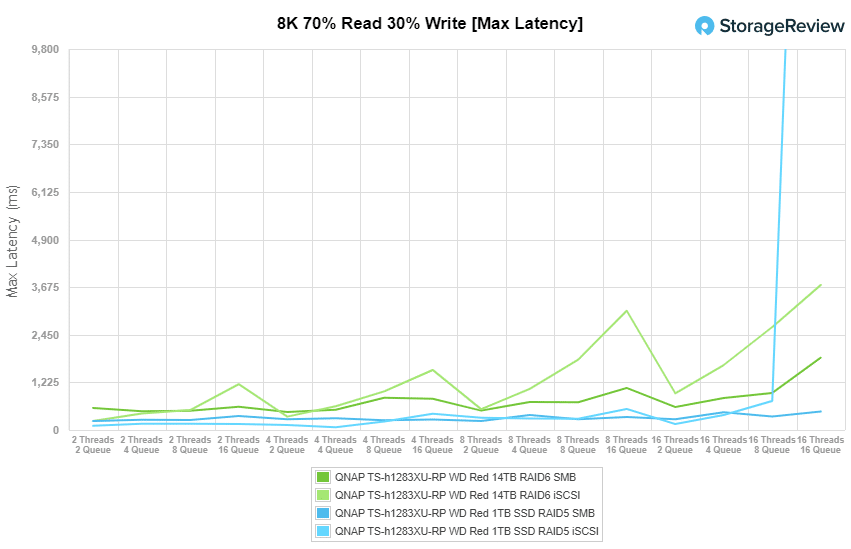
With 8K 70/30 standard deviation, the HDDs saw ranges of 13.3ms to 442ms in iSCSI and 17.4ms to 180ms in SMB. The SSDs saw ranges of 1.4ms to 368.5ms in iSCSI and 5.2ms to 63.5ms in SMB.
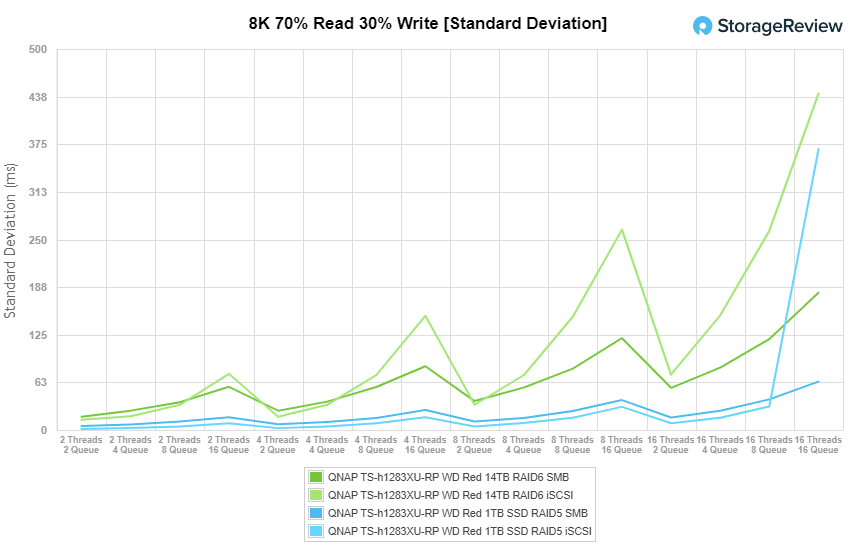
The last Enterprise Synthetic Workload benchmark is our 128K test: a large-block sequential test that shows the highest sequential transfer speed for a device. In this workload scenario, the HDD performance hit 2GB/s read and 1.4GB/s write for iSCSI and 2.2GB/s read 2.1GB/s write for SMB. The SSDs saw similar performance with 2GB/s read and 1.6GB/s write for iSCSI and 1.6GB/s read and 2.1GB/s write for SMB.
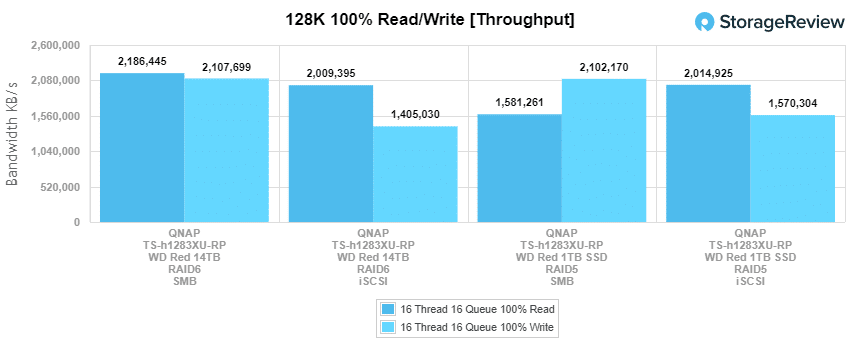
Conclusion
The QNAP TS-h1283XU-RP is a QuTS hero-based 2U, rackmount NAS that is aimed at providing optimized performance and better data protection. The NAS leverages the newer ZFS-based OS as well as an Intel Xeon E processor, up to 128GB of RAM, and onboard 10GbE (both RJ45 and SFP+ ports). Users can leverage SSD caching for better performance and added various connectivity through the six PCIe slots in the back. The NAS is positioned as a mission-critical file server, virtualization server, VDI, collaborative video editing, or efficient file backup and recovery applications. Expectations should be tempered however as the drive bays are all SATA.
For performance, we ran our Enterprise Synthetic Workload Analysis for NAS. We tested with a set of WD Red 14TB HDDs in RAID6 and a set of WD Red 1TB SSDs in RAID5 in both iSCSI and SMB configurations. It should be noted here that we turned synchronized writes off as well as disabling compression and deduplication. Turning those items on will have benefits for data integrity and space optimization, although will force further performance hits.
Let’s first look at the HDDs. In 4K throughput, we saw 676 IOPS read and 565 IOPS write for iSCSI and 432 IOPS read and 192 IOPS write for SMB. 4K average latency gave us 378ms read and 333ms write for iSCSI and 591ms read and 1,326ms write for SMB. 4K max latency saw 4,407ms read and 4,269ms write in iSCSI and 2,620ms read and 4,456ms write for SMB. 4K standard deviation hit 415ms read and 491ms write for iSCSI and 553ms read and 1,193ms for SMB. For 8K sequential the NAS performed at 81,533 IOPS read and 62, 131 IOPS write with iSCSI while the SMB saw 60,790 IOPS read and 33,909 IOPS write. Large-block 128K sequential speeds were 2GB/s read and 1.4GB/s write for iSCSI and 2.2GB/s read 2.1GB/s write for SMB.
Next up, let’s look at the SSD performance. In 4K throughput, we saw 5,590 IOPS read and 3,070 IOPS write for iSCSI and 4,376 IOPS read and 769 IOPS write for SMB. 4K average latency gave us 43ms read and 83ms write in iSCSI and 59ms read and 333ms write for SMB. 4K max latency saw 3,427ms read and 1,266ms write in iSCSI and 1,938ms read and 1,875ms write in SMB. 4K standard deviation hit 108ms read and 98ms write in iSCSI and 94ms read and 289ms write in SMB. For 8K sequential the NAS performed at iSCSI hitting 161,758 IOPS read and 133,028 IOPS write and the SMB hitting 62,890 IOPS read and 35,307 IOPS write. Large-block 128K sequential speeds were 2GB/s read and 1.6GB/s write for iSCSI and 1.6GB/s read and 2.1GB/s write for SMB.
ZFS and QuTS hero give QNAP an opportunity to ship NAS systems for SMBs that are more hardened from a data integrity standpoint and offer more enterprise-style features, like data reduction and efficient snapshots. The QNAP TS-h1283XU-RP specifically, does this relatively economically as well. At a street price of $4k bare it’s not inexpensive, but for a 12-bay rackmount NAS with these capabilities, it’s not unreasonable either. The big question is around performance/workload matching. Performance in small block workloads wasn’t great, but the system handled big blocks pretty well for a SATA-based system. We’d prefer something with NVMe as a primary system, but for branch/remote offices or as a replication/backup target, the QNAP TS-h1283XU-RP does well.




 Amazon
Amazon